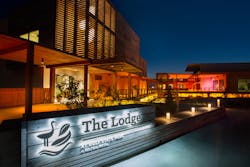Ketra leveraged Earth Day on Apr. 22 to announce details on a turtle-friendly outdoor lighting project at The Lodge at Gulf State Park located in Gulf Shores, AL. The LED-based lamps and luminaires used in the project produce an extremely warm light restricted specifically by wavelength so as not to confuse hatchling turtles in their initial crawl to the ocean. The application takes advantage of Ketra’s proprietary LED-based light engines that feature a multi-channel solid-state lighting (SSL) architecture.
Hatchling turtles instinctively crawl toward cool white light after being born. Generally in the wild, the source of that target is moonlight being reflected off the surface of the ocean. Artificial lighting mounted on buildings or even street lights can confuse the turtles, and researchers have said that initial trip to the ocean is among the most dangerous of times in the life of such turtles.
We have written about this issue sporadically going back more than a decade. In our coverage of the Street and Area Lighting Conference back in 2015, we even described how Florida Power and Light (FPL) uses its street-light network to automatically turn off select luminaires in turtle nesting areas just during hatchling season.
The more typical approach has been the deployment of lamps or luminaires developed using amber LEDs, and we have covered such products. The Florida Wildlife Commission (FWC) has published guidelines suggesting that no light with any wavelength emission shorter than 560 nm be allowed in turtle nesting areas. That wavelength specification is far more stringent than would be a color-temperature or CCT-based specification because even very warm phosphor-converted LED sources still include blue energy in their spectral power distribution (SPD).
Amber LEDs, however, aren’t ideal. They are less efficient than white LEDs for now and cost more as well. You might think that widely available tunable lamps or luminaires might be the answer, but most would have the blue-energy issue mentioned above.
Ketra, meanwhile, developed its own light engine to deliver a far greater range of tunability, primarily for human-centric lighting or lighting for health and wellbeing applications. We wrote extensively about the technology in a two-part series on a project in a high-end residence.
Ketra has never publicly revealed the details of its light engine. But it clearly includes some monochromatic LEDs most likely in the red range, along with several more LED channels. That red energy would improve color rendering in a general lighting application and be better for humans at night. Tuning such a source to the 580-nm wavelength — we suspect only powering the red LEDs — as is the case in the lodge installation means that turtles will ignore the lights, yet humans will still see well enough to safely navigate walkways around the property. The project utilizes both S30 LED replacement lamps and D3 downlights.
“Guests are always curious why the lighting is a bit different at night, so we explain that not only does the warm, long-wavelength light help the sea turtles, it’s also beneficial for humans as a natural cue that helps prepare the body for sleep,” said Robert Stoney, director of sustainability at The Lodge at Gulf State Park. “It helps reinforce our goal of being responsible for our surrounding environment and ensuring an incredible guest experience.”
*Updated Apr. 22, 2020 for link detail and venue name.






